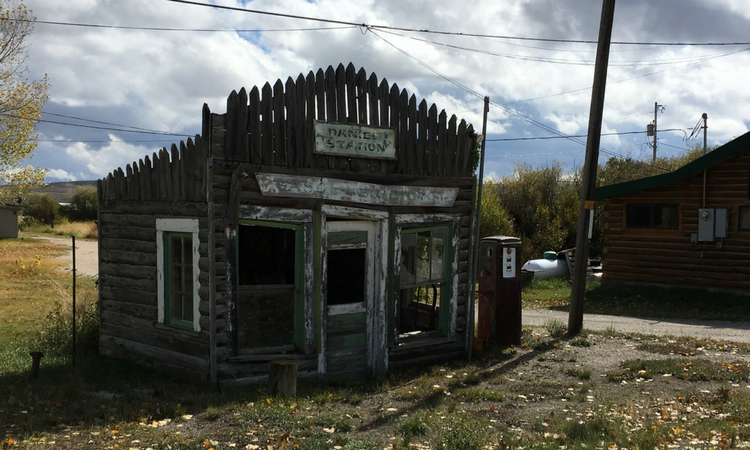
Daniel, WY: A little corner of paradise.
How The Sierra Club Sold the US Environment Down the River For $100 Million
After reading this post, you could be forgiven for believing that I’m perpetually on the road, leading the Life of Riley. And you won’t get much of an argument from me; this retired life is sweet.
My latest trip was what my wife describes as my “slow boat to China” drive to visit our daughter and her family in Spokane. What a fabulous country we still have. And I saw some of the best of it.
My advice to you? Get out and see it for yourself before it’s overwhelmed by population growth. Which is the highest of any of the advanced industrial countries. And is driven primarily by immigration-both legal and illegal. The mid-range estimate by the US Census Bureau for our 2100 population? Nearly 600 million people. And on the high side? Well over a billion.
So, staying off interstate highways to the extent possible, I took about eight days to make the trip.
Going first over the spectacular Trail Ridge Road, I spent a night at the venerable Grand Lake Lodge.
The next day, on to Steamboat Springs where I stopped into the F.M. Light store and picked up a beautiful, western belt buckle to go with my Stetson. Now, I can honestly claim to be a full fledged cowboy. Except, of course, for the cow, the boy and the horse.
That night I stayed at the Little America motel, just west of Rock Springs, Wyoming. Talk about a trip down memory lane. When I was a kid, we made annual pilgrimages to Idaho to visit relatives. Little America, with its innumerable road signs counting down the miles until we could get an ice cream cone, relieved what seemed to be an endless ride in a cramped back seat across those vast stretches of sage brush country.
As the sun crept over the eastern horizon the next morning, I left I-80 behind and went north to the hardscrabble town of Kemmerer. In the heart of Wyoming energy country, it’s the improbable home of the J.C. Penny mother store.
North of Kemmerer, the country went from starkly beautiful to hauntingly lonely. Nothing except antelope and snow fences for mile after mile.
Until, that is, I came to a slightly wider spot in the road called Daniel. Its ramshackled structures are being slowly reclaimed by the harsh Wyoming winters. For several years in the 1830’s, it was home to the legendary fur trappers’ rendezvous that highlighted the rough and ready lives of the mountain men who blazed the trial west for the homesteaders that followed.
Again. It’s a paradise you need to see before it’s paved to accommodate the hordes of migrants that are making our country a world sacrifice zone.
But, in reality, it’s not the migrants’ fault. They’re just doing what comes naturally. That is, leaving the hell holes they’ve made of their own countries. And rather than doing the hard work of fixing things there, taking the path of least resistance and moving to paradise. In other words, the good old U.S. of A. You know, Texas tea, swimming pools, movie stars. Not to mention food stamps, welfare and Section 8 housing.
And, of course, you’re right. Not all are coming here for welfare-many are coming for jobs. But that doesn’t mean they’re having any less impact on our environment: the air, the water, and our wild lands.
But don’t tell me that they can’t fix their own countries. I’m 66 years old. Within my lifetime, China was an impoverished, murderous hellhole. But now, by most measures, their economy is bigger than ours. And all without a penny of US foreign aid. Not to mention mass immigration.
And if you’re counting on organizations, like the Sierra Club, that you thought were devoted to protecting our environment to save us, you’re fooling yourself. They won’t. In fact, they were bought and paid for by the “more people is better” lobby years ago.
For me, this strange story begins when I was in the legislature and introduced a bill that would have required every employer in the state to use the federal E-Verify system. E-Verify enables employers, with a high degree of reliability, to determine whether a person applying for a job is in the country is here legally and so eligible to work. Since jobs are considered one of the leading “magnets” for illegal immigrants, effectively preventing them from working here would go a long way towards “demagnetizing” the US.
Naïvely assuming that environmental groups would want to limit the environmental damage caused by population growth, I spoke with a woman named Pam Kiely, who was the lobbyist for a coalition of environmental groups. With the capital’s golden dome soaring far above our heads, I vividly remember our discussion over the hubbub of other lobbyists and legislators on the stairs just outside the Senate chamber.
Her response to mandatory E-Verify? “Of course, we’re concerned about population growth,” she said. “But only from the perspective of world wide population growth. So,” she concluded, “we can’t support your bill.”
So, there you have it. We tackle urban sprawl and traffic congestion on Colorado’s Front Range by reducing population growth in Mexico. And Africa. Sort of like boiling the ocean: good luck with that. And in the mean time ignore immigration.
Of course, it wasn’t always like this for groups like the Sierra Club. As recently as 1989, the Club’s position was that it should work to bring about population stabilization “first of the United States and then of the world.”
What caused the Sierra Club to do a 180 degree turn on The Population Bomb (a book the Club helped get published) with respect to America’s environment? You guessed it: money.
In the early 1990’s, California plutocrat, David Gelbaum, told then Club president Carl Pope that that if the Club ever came out anti-immigration “they would never get a dollar from me.” Pope obediently complied; the Club changed it’s tune. Gelbaum then ponied up a cool $100 million or so-the largest gift in Club history.
The issue has remained contentious in the Club. Proponents of limiting immigration have been denounced as “racist;” the perfect tool for shutting down reasoned debate.
The controversy also has significant Colorado connections. Former Governor, Richard Lamm, a Democrat, has been one of the activists fighting to bring the Club back to its immigration limitation roots. He also joined in a recent law suit alleging that the federal Department of Homeland Security has failed in its obligation to enforce the Environment Protection Act by ignoring the impact of legal and illegal immigration on the environment. Lamm charges that ignoring the impact of immigration is “environmental malpractice.”
The Sierra Club has a pretty website: seals, polar bears, stunning vistas. Very slick. Very politically correct. It hits all the right environmental notes. Except, of course, on what immigration is doing to the American environment.
There’s a saying in politics that goes, “Money talks, bullsh*t walks.” The Sierra Club, from first hand experience, knows a lot about how that works.
So the next time you’re enjoying a weekend at your favorite “secret” spot in the back country, remember this: with the waves of immigrants coming this way, it probably won’t be a secret for long. You better get out and see it again before they pave it. And put up a parking lot.



